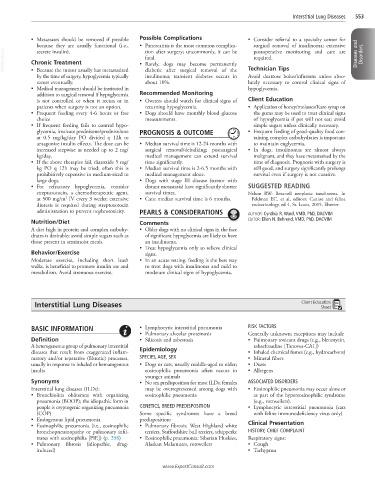Page 1110 - Cote clinical veterinary advisor dogs and cats 4th
P. 1110
Interstitial Lung Diseases 553
• Metastases should be removed if possible Possible Complications • Consider referral to a specialty center for
because they are usually functional (i.e., • Pancreatitis is the most common complica- surgical removal of insulinoma; extensive
VetBooks.ir Chronic Treatment • Rarely, dogs may become permanently Technician Tips Diseases and Disorders
tion after surgery; uncommonly, it can be
secrete insulin).
postoperative monitoring and care are
required.
fatal.
• Because the tumor usually has metastasized
insulinoma; transient diabetes occurs in
by the time of surgery, hypoglycemia typically diabetic after surgical removal of the Avoid dextrose bolus/infusions unless abso-
recurs eventually. about 10%. lutely necessary to control clinical signs of
• Medical management should be instituted in hypoglycemia.
addition to surgical removal if hypoglycemia Recommended Monitoring
is not controlled or when it recurs or in • Owners should watch for clinical signs of Client Education
patients when surgery is not an option. returning hypoglycemia. • Application of honey/molasses/Karo syrup on
• Frequent feeding every 4-6 hours or free • Dogs should have monthly blood glucose the gums may be used to treat clinical signs
choice measurements. of hypoglycemia if pet will not eat; avoid
• If frequent feeding fails to control hypo- simple sugars unless clinically necessary.
glycemia, institute prednisone/prednisolone PROGNOSIS & OUTCOME • Frequent feeding of good-quality food con-
at 0.5 mg/kg/day PO divided q 12h to taining complex carbohydrates is important
antagonize insulin effects. The dose can be • Median survival time is 12-24 months with to maintain euglycemia.
increased stepwise as needed up to 2 mg/ surgical removal/debulking; postsurgical • In dogs, insulinomas are almost always
kg/day. medical management can extend survival malignant, and they have metastasized by the
• If the above therapies fail, diazoxide 5 mg/ time significantly. time of diagnosis. Prognosis with surgery is
kg PO q 12h may be tried; often this is • Median survival time is 2-6.5 months with still good, and surgery significantly prolongs
prohibitively expensive in medium-sized to medical management alone. survival even if surgery is not curative.
large dogs. • Dogs with stage III disease (tumor with
• For refractory hypoglycemia, consider distant metastasis) have significantly shorter SUGGESTED READING
streptozotocin, a chemotherapeutic agent, survival times. Nelson RW: Beta-cell neoplasia: insulinoma. In
2
at 500 mg/m IV every 3 weeks; extensive • Cats: median survival time is 6 months. Feldman EC, et al, editors: Canine and feline
diuresis is required during streptozotocin endocrinology, ed 4, St. Louis, 2015, Elsevier.
administration to prevent nephrotoxicity. PEARLS & CONSIDERATIONS AUTHOR: Cynthia R. Ward, VMD, PhD, DACVIM
Nutrition/Diet Comments EDITOR: Ellen N. Behrend, VMD, PhD, DACVIM
A diet high in protein and complex carbohy- • Older dogs with no clinical signs in the face
drates is desirable; avoid simple sugars such as of significant hypoglycemia are likely to have
those present in semimoist meals. an insulinoma.
• Treat hypoglycemia only to relieve clinical
Behavior/Exercise signs.
Moderate exercise, including short leash • In an acute setting, feeding is the best way
walks, is beneficial to promote insulin use and to treat dogs with insulinoma and mild to
metabolism. Avoid strenuous exercise. moderate clinical signs of hypoglycemia.
Interstitial Lung Diseases Client Education
Sheet
BASIC INFORMATION • Lymphocytic interstitial pneumonia RISK FACTORS
• Pulmonary alveolar proteinosis Generally unknown; exceptions may include
Definition • Silicosis and asbestosis • Pulmonary toxicant drugs (e.g., bleomycin,
A heterogeneous group of pulmonary interstitial Epidemiology rabacfosadine [Tanovea-CA1])
diseases that result from exaggerated inflam- • Inhaled chemical fumes (e.g., hydrocarbons)
matory and/or reparative (fibrotic) processes, SPECIES, AGE, SEX • Mineral fibers
usually in response to inhaled or hematogenous • Dogs or cats, usually middle-aged to older; • Dusts
insults eosinophilic pneumonia often occurs in • Allergens
younger animals
Synonyms • No sex predisposition for most ILDs; females ASSOCIATED DISORDERS
Interstitial lung diseases (ILDs): may be overrepresented among dogs with • Eosinophilic pneumonia may occur alone or
• Bronchiolitis obliterans with organizing eosinophilic pneumonia as part of the hypereosinophilic syndrome
pneumonia (BOOP); the idiopathic form in (e.g., rottweilers).
people is cryptogenic organizing pneumonia GENETICS, BREED PREDISPOSITION • Lymphocytic interstitial pneumonia (cats
(COP) Some specific syndromes have a breed with feline immunodeficiency virus only)
• Endogenous lipid pneumonia predisposition: Clinical Presentation
• Eosinophilic pneumonia (i.e., eosinophilic • Pulmonary fibrosis: West Highland white
bronchopneumopathy or pulmonary infil- terriers, Staffordshire bull terriers, schipperke HISTORY, CHIEF COMPLAINT
trates with eosinophilia [PIE]) (p. 298) • Eosinophilic pneumonia: Siberian Huskies, Respiratory signs:
• Pulmonary fibrosis (idiopathic, drug- Alaskan Malamutes, rottweilers • Cough
induced) • Tachypnea
www.ExpertConsult.com

